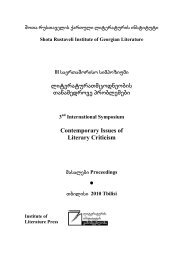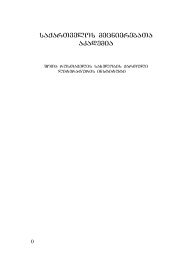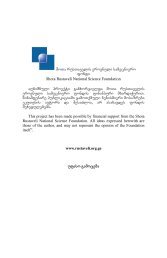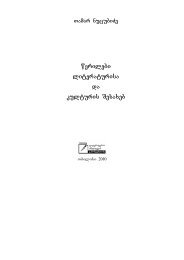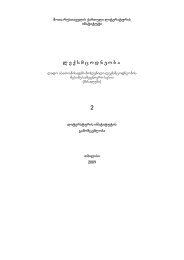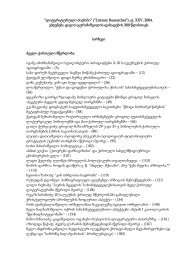SoTa rusTavelis qarTuli literaturis instituti - Tbilisi State University
SoTa rusTavelis qarTuli literaturis instituti - Tbilisi State University
SoTa rusTavelis qarTuli literaturis instituti - Tbilisi State University
Create successful ePaper yourself
Turn your PDF publications into a flip-book with our unique Google optimized e-Paper software.
From Byzantium to Bulgaria and to Georgia – Modifications and Typological Similarities between<br />
Old Bulgarian and Georgian Hymnography<br />
names of hymnographers have reached us, namely: Constantine, the bishop of Preslav; St.<br />
Clement of Ohrid; and St. Naum of Ohrid. The vicissitudes of history have deprived us of<br />
Slavic hymnographic manuscripts from that early epoch.<br />
In Georgian hymnography, whose beginning is usually considered to be in the 8 th c.<br />
(Kекеlidze 1944; Grigolashvili 1979: 174), the 10th c. is defined as the climax (classical<br />
period) of original chant poetry. By virtue mostly of the unique hymnographic miscellany<br />
preserved until the present day and compiled in the years 978–988 by the Georgian hymnographer<br />
Mikael Modrekili, more than a few names of Georgian hymnographers from<br />
that epoch have reached us, including those of Ioane Minchkhi, bishop Ioane Mtbеvаri,<br />
Kurdanai, Ezra, Stepane (Sananoisdze), the bishop of Chkondidi, Ioane Konkozisdze, and<br />
Mikael Modrekili. Like original Slavonic chant poetry from that time, Georgian hymnography<br />
was concentrated mainly in Georgia and more specifically in the monasteries in the<br />
Kingdom of Tao-Klarjeti (Grigolashvili 1979: 175–176; Dzhgamaya 2000: 406).<br />
One of the most typical motivations to compose original chants was, of course, the<br />
need for liturgical services for the newly canonized national saints. This need remained<br />
valid for practically the whole time frame encompassing the existence of original hymnography.<br />
In Slavic literature, already in the 9th c. the disciples of Cyril and Methodius wrote<br />
services in honor of their teachers, whom the Church considers equal to the Apostles.<br />
Four such works are known today: a service for St. Methodius written by Constantine of<br />
Preslav, a canon for the same by St. Clement of Ohrid, an anonymous service for St. Cyril,<br />
and an anonymous canon for the two brothers (Istoriya: 124). In Georgian hymnography,<br />
scholars have determined that the first original work was a chant by Ioane Sabanidze from<br />
the 8th c. about the martyrdom of the Arab Abo Tbileli, who was converted to Christianity<br />
(Kekelidze 1944).<br />
The creative attitude towards adopted Byzantine hymnography can be clearly seen<br />
in the fact that both Slavic and Georgian hymnographers from the 9th–10th c. composed<br />
plenty of chants in honor not only of national saints, but also for ecumenical feasts, for<br />
which Greek liturgical masterpieces already existed. Thus, in reference to original Old<br />
Bulgarian hymnography for Christmas and Epiphany (a canon for Christmas by Constantine<br />
of Preslav, an anonymous canon for Epiphany, pre-festive and post-festive stichera),<br />
Georgi Popov – the discoverer of many of these chants – noted: “It is interesting that like<br />
the Old Bulgarian hymnographers, the Georgian writers have also composed a number of<br />
works in similar genres in honor of the feasts of Christmas and the Epiphany. For example,<br />
the iambic canons for the pre-festive Christmas cycle by Ioane Mtbevari – the Georgian<br />
hymnographer from the 10th c. – are well known, as are his stichera for Christmas, Epiphany<br />
and others” (Popov 2002: 380–381). *<br />
We also can identify another parallel between the two chant traditions from the<br />
9th–10th c. in the Menaion repertoire. They include a canon for St. Euthymius the Great<br />
by St. Clement of Ohrid (Stanchev, Popov 1988: 120–129, 170–181) and a canon (preserved<br />
in the tropologion of Mikael Modrekili) for the same saint by the Georgian hym-<br />
* In the original: “Интересен е фактът, че подобно на старобългарските песнописци грузинските книжовници<br />
създават редица сходни в жанрово отношение творби, посветени на празниците Рождество Христово<br />
и Богоявление. Така например известни са ямбически канони на грузинския песнописец от Х в.<br />
Йоан Мтбевари за предпразничния Рождественски цикъл, негови стихири за Рождество Христово, за<br />
Богоявление и др.”<br />
147



